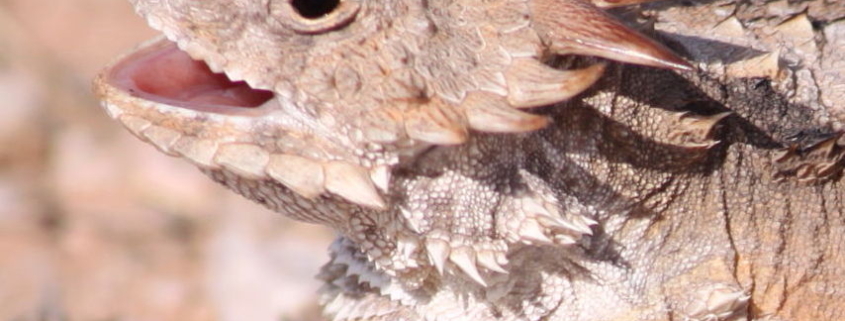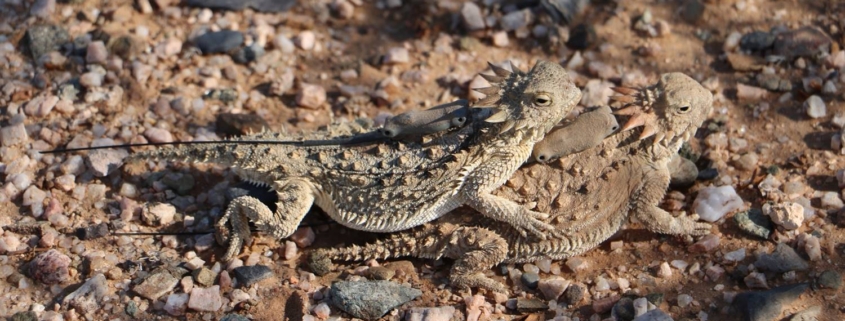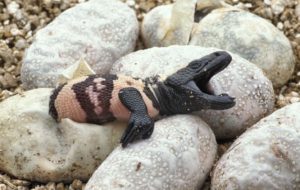
The Natural History of Regal Horned Lizards, Phrynosoma solare
– Brian K. Sullivan, PhD –
Professor Emeritus, Arizona State University
Venue details below
 From 2015 through 2020 we used radio-telemetry to investigate spatial and behavioral ecology of the Regal Horned Lizard (Phrynosoma solare) in the Sonoran Desert near Phoenix, Arizona, USA. Our results reveal dramatic variation in space use and behavior by season and sex over the course of a relatively brief annual activity period (April to October). Brumation at the base of shrubs occurred from early fall (late September and October) through late spring (April and May) for males (~ 195 days); females were inactive for significantly shorter period (~ 180 days) but still much longer than expected for a desert dwelling ectotherm. The emergence period (April and May) was characterized by relatively little movement, and a post-brumation ecdysis event prior to the mating period (June and July). Males (80 m per day) moved significantly more than females (30 m day) during the mating period and mated with up to four different females during this prolonged mate-searching period. The nesting period (August) was characterized by increasingly less movement by males, who began brumation as early as 20 September, and nesting and nest guarding by females. This was followed by a pre-brumation period (September) which included a second ecdysis event. Home range size varied across these activity periods and was highest for males during the mating period. Overall, annual minimum convex polygon (= MCP) home ranges of males (mean = 8.4 ha, N = 14) were more than four times the size of female home ranges (mean = 1.9 ha, N = 18).
From 2015 through 2020 we used radio-telemetry to investigate spatial and behavioral ecology of the Regal Horned Lizard (Phrynosoma solare) in the Sonoran Desert near Phoenix, Arizona, USA. Our results reveal dramatic variation in space use and behavior by season and sex over the course of a relatively brief annual activity period (April to October). Brumation at the base of shrubs occurred from early fall (late September and October) through late spring (April and May) for males (~ 195 days); females were inactive for significantly shorter period (~ 180 days) but still much longer than expected for a desert dwelling ectotherm. The emergence period (April and May) was characterized by relatively little movement, and a post-brumation ecdysis event prior to the mating period (June and July). Males (80 m per day) moved significantly more than females (30 m day) during the mating period and mated with up to four different females during this prolonged mate-searching period. The nesting period (August) was characterized by increasingly less movement by males, who began brumation as early as 20 September, and nesting and nest guarding by females. This was followed by a pre-brumation period (September) which included a second ecdysis event. Home range size varied across these activity periods and was highest for males during the mating period. Overall, annual minimum convex polygon (= MCP) home ranges of males (mean = 8.4 ha, N = 14) were more than four times the size of female home ranges (mean = 1.9 ha, N = 18).
 Professor Sullivan received his BA in zoology from University of California, Berkeley, in 1979, and his PhD in zoology from Arizona State University in 1983. Subsequently, he was a lecturer at the University of Texas, Austin, prior to his appointment as an assistant professor at the University of Maine, Orono. He returned to ASU as an assistant professor in 1989. He served as the Editor of the Journal of Herpetology from 2000 through 2005. He has spent over 50 years investigating the behavior, conservation, ecology and evolution of amphibians and reptiles of the Sonoran Desert. He has authored roughly 200 articles, book reviews, technical reports, and book chapters, including many coauthored with students and colleagues in the American Southwest. He retired in 2023, freeing up time for research, and is now an emeritus professor at ASU.
Professor Sullivan received his BA in zoology from University of California, Berkeley, in 1979, and his PhD in zoology from Arizona State University in 1983. Subsequently, he was a lecturer at the University of Texas, Austin, prior to his appointment as an assistant professor at the University of Maine, Orono. He returned to ASU as an assistant professor in 1989. He served as the Editor of the Journal of Herpetology from 2000 through 2005. He has spent over 50 years investigating the behavior, conservation, ecology and evolution of amphibians and reptiles of the Sonoran Desert. He has authored roughly 200 articles, book reviews, technical reports, and book chapters, including many coauthored with students and colleagues in the American Southwest. He retired in 2023, freeing up time for research, and is now an emeritus professor at ASU.



